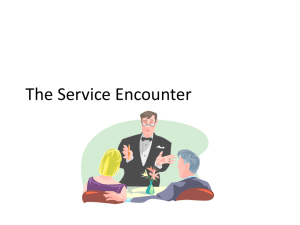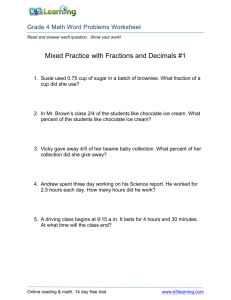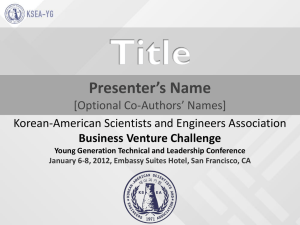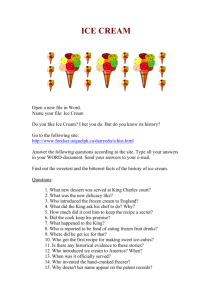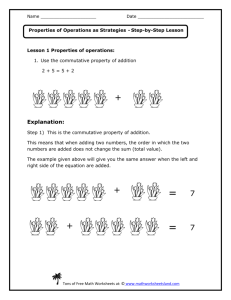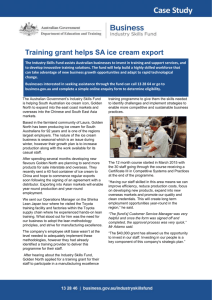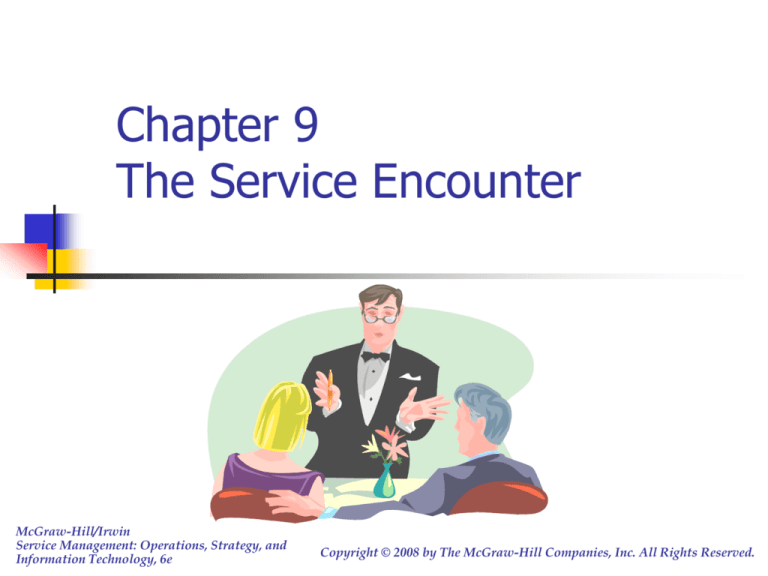
Chapter 9
The Service Encounter
McGraw-Hill/Irwin
Service Management: Operations, Strategy, and
Information Technology, 6e
Copyright © 2008 by The McGraw-Hill Companies, Inc. All Rights Reserved.
Learning Objectives
Use the service encounter triad to describe a service firm’s delivery
process.
Explain how the culture and level of employee empowerment in an
organization affect the service encounter.
Differentiate four organizational control systems for employee
empowerment.
Describe the classification of customers into four groups based on
their attitudes and expectations.
Prepare abstract questions and write situational vignettes to screen
recruits.
Describe how the creation of an ethical climate leads to job
satisfaction and service quality.
Discuss the role scripts in customer coproduction.
Describe how elements of the service profit chain lead to revenue
growth and profitability.
8-2
The Service Triangle
Service
Organization
Control
versus
autonomy
Efficiency
versus
satisfaction
Contact
Personnel
Customer
Perceived
control
Note: Perceived control determines if a relationship or encounter
is established between contact personnel and customer.
8-3
Service Encounter Success Factors
Customer
Service Provider
Human
Machine
Human
Employee selection
Interpersonal skills
Support technology
Engender trust
User friendly
Verification
Security
Easy to access
Machine
Easy to access
Fast response
Verification
Remote monitoring
Compatibility
Tracking
Verification
Security
8-4
The Customer
Expectations and Attitudes
Economizing customer
Ethical customer
Personalizing customer
Convenience customer
Customer as Coproducer
8-5
Definitions of Culture
Schwartz and Davis (1981) - Culture is a
pattern of beliefs and expectations shared by
the organization’s members.
Mintzberg (1989) - Culture is the traditions
and beliefs of an organization that distinguish
it from others.
Hoy and Miskel (1991) - Culture is shared
orientations that hold the unit together and
give a distinctive identity.
8-6
The Service Organization
Culture
ServiceMaster (Service to the Master)
Disney (Choice of language)
Empowerment
Invest in people
Use IT to enable personnel
Recruitment and training critical
Pay for performance
8-7
Organizational Control
Control
System
Objective
Employee
Challenge
Management
Challenge
Key Issues
Belief
Contribute
Uncertainty about
purpose
Communicate core
values and mission
Identify core
values
Boundary
Compliance
Pressure or temptation
Specify and enforce
rules
Risks to be
avoided
Diagnostic
Achieve
Lack of focus
Build and support clear
targets
Critical
performance
variables
Interactive
Create
Lack of opportunity or
fear of risk taking
Open organizational
dialogue to
encourage learning
Strategic
Uncertainties
8-8
Contact Personnel
Selection
1. Abstract Questioning
2. Situational Vignette
3. Role Playing
Training
Unrealistic customer expectations
Unexpected service failure
8-9
Difficult Interactions with
Customers
Unrealistic customer expectations
1. Unreasonable demands
2. Demands against policies
3. Unacceptable treatment of
employees
4. Drunkenness
5. Breaking of societal norms
6. Special-needs customers
Unexpected service failure
1. Unavailable service
2. Slow performance
3. Unacceptable service
Use scripts to train for proper response
8-10
Examples of Unethical Behaviors
Misrepresenting the Nature
of the Service
Customer Manipulation
• Promising a nonsmoking
room when none is
available
• Using bait-and-switch
tactics
• Creating a false need for
service
• Misrepresenting the
credentials of the service
provider
• Exaggerating the benefits of
a specific service offering
• Giving away a guaranteed
reservation
• Performing unnecessary
services
• Padding a bill with hidden
charges
• Hiding damage to customer
possessions
• Making it difficult to
invoke a service
guarantee
General Honesty and
Integrity
• Treating customers
unfairly or rudely
• Being unresponsive to
customer requests
• Failing to follow stated
company policies
• Stealing customer credit
card information
• Sharing customer
information with third
parties
8-11
Employee Perceptions of Customer
Service at a Branch Bank
Outstanding
6
Customer
5
4
3
2
Terrible
1
1
Terrible
2
3
4
Employee
5
6
Outstanding
8-12
Satisfaction Mirror
More
Repeat
Purchases
Stronger Tendency
to Complain about
Service Errors
Higher Customer
Satisfaction
Lower Costs
Better Results
More Familiarity with
Customer Needs and
Ways of Meeting
Them
Greater Opportunity
for Recovery
from Errors
Higher Employee
Satisfaction
Higher Productivity
Improved Quality
of Service
8-13
Service Profit Chain
Internal
External
Operating strategy and
service delivery system
Service
concept
Target market
Loyalty
Revenue
growth
Customers
Satisfaction
Employees
Capability
Productivity
&
Output
quality
Service
value
Satisfaction
Loyalty
Profitability
Service
quality
Customer orientation/quality emphasis
Allow decision-making latitude
Selection and development
Rewards and recognition
Information and communication
Provide support systems
Foster teamwork
Quality & productivity
improvements yield
higher service quality
and lower cost
Attractive Value
Service designed
& delivered to
meet targeted
customers’ needs
Solicit customer
feedback
Lifetime value
Retention
Repeat Business
Referrals
8-14
Topics for Discussion
How does the historical image of service as servitude
affect today’s customer expectations and service employee
behavior?
What are the organizational and marketing implications of
considering a customer as a “partial employee”?
Comment on the different dynamics of one-on-one service
and group service.
How does use of a “service script” relate to service
quality?
If the roles played by customers are determined by
cultural norms, how can services be exported?
8-15
Interactive Exercise
The class breaks into small groups and
each group comes up with an example
from each of the four organizational
control systems (i.e., belief, boundary,
diagnostic, and interactive)
8-16
Amy’s Ice Cream
1.
2.
3.
Describe the service organization culture at
Amy’s Ice Cream.
What are the personality attribute of the
employees who are sought by Amy’s Ice
Cream?
Design a personnel selection procedure for
Amy’s Ice Cream using abstract
questioning, a situational vignette, and/or
role playing.
8-17
AMY’S ICE CREAM
Situational Vignette
A particular customer has the irritating
habit of always showing up about two
minutes before closing and staying late.
Often this occurs on the night when
weekly store meeting are held after
closing time. This delays starting the
meeting and furthermore employees are
on the clock waiting for the customer to
leave. What would you do?
8-18
AMY’S ICE CREAM
Situational Vignette
As a new employee at a busy store, you
have been routinely performing cleanup tasks (garbage removal and
restroom cleaning). Company policy
dictates that these are tasks to be
shared. It has become clear that two
employees consistently avoid these jobs
in favor of more pleasant duties.
How would you handle this situation?
8-19


